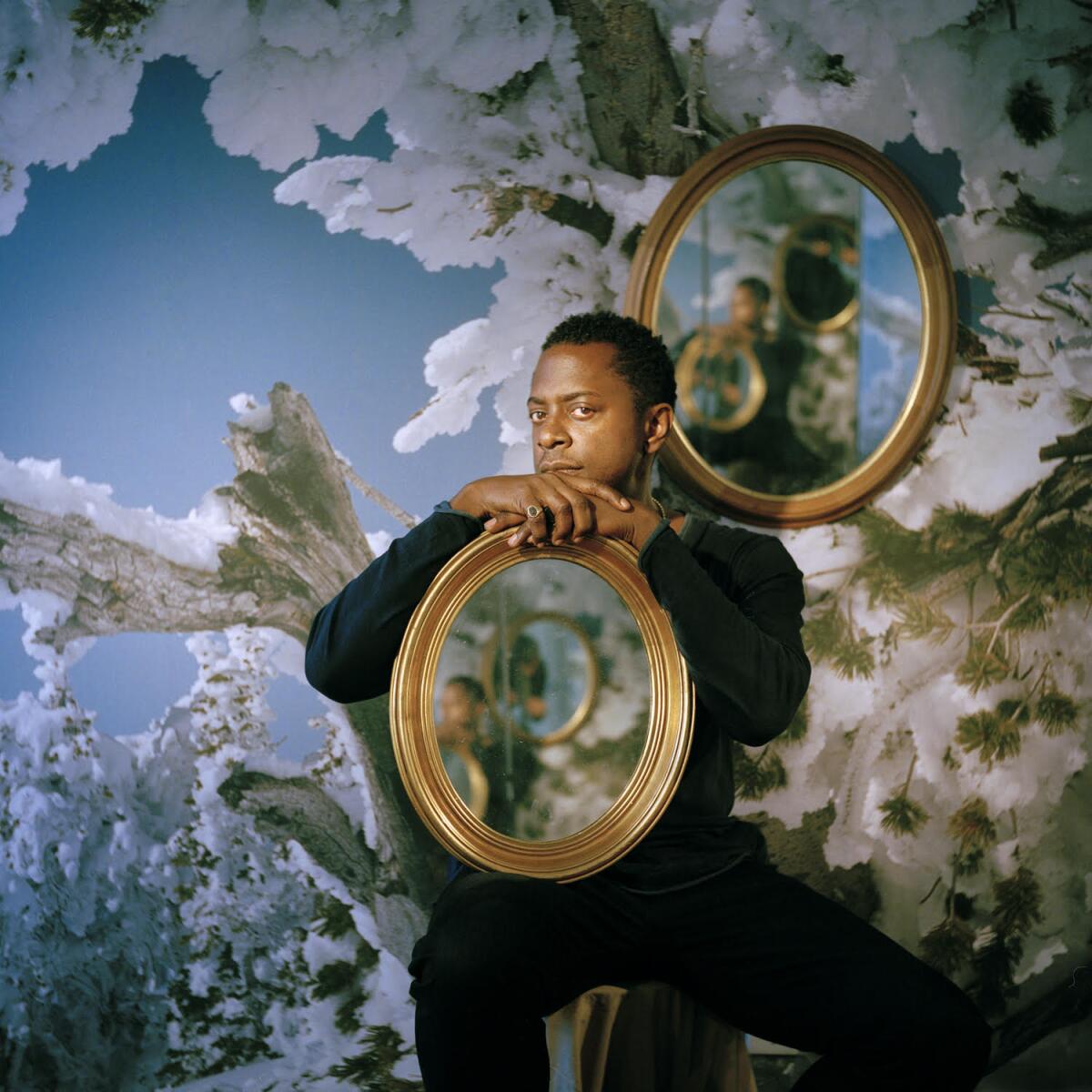Artist Sanford Biggers will create a large-scale sculpture for OCMA’s fall opening

- Share via
When the Orange County Museum of Art opens to the public on Oct. 8, a large-scale work by Sanford Biggers will greet visitors atop the museum’s sculpture terrace. The site-specific piece — a 24-foot-wide, 16-foot-tall steel and aluminum sculpture — is a new commission from OCMA. The institution will also honor the artist at its Oct. 1 gala, the museum announced Thursday.
The work, “Of many waters …” (2022), is an interactive piece, with benches on the back side of it that visitors can sit on. The museum describes it as “an archetype of a European reclining male figure with a 19th Century Baule double-face mask made from metal sequins.” The giant, two-toned sequins flutter in the wind and shimmer in the sun so that the piece changes dimensions throughout the day.
“It’s a piece that really looks at our notions of beauty and power and representation by using classical sculpture, both European and African,” Biggers says. “And it’s done in a material that’s different from any of those classical sculptures — it’s not marble, it’s not stone, it’s not wood or bronze. It’s this two-tone metal sequin type of material. It’s a hybrid representation.”
The sculpture’s materials, he adds, “make that conversation a bit more contemporary and syncretic, seeing that our standard of beauty and notions of power are all intertwined at this point.”
“Of many waters …” will remain on view through Feb. 5, 2023, at which point it will be swapped out for a different sculpture — all part of director Heidi Zuckerman’s vision for the outdoor space to become a central museum spot for hosting events and showcasing rotating works.
The nearly $94-million museum building, located at Costa Mesa’s Segerstrom Center for the Arts, has been under construction since fall 2019. It was designed by Morphosis Architects and directed by Pritzker Prize-winning architect Thom Mayne.
Biggers’ piece is the ideal sculpture to mark the terrace’s debut, Zuckerman says.
“The work is celebrating the multiplicity of contemporary life, how we’re really blended in our time and that no one is one thing, we’re all many things,” Zuckerman says. “And by acknowledging our multiplicity, it becomes a vehicle for understanding. It’s a really hopeful piece.”

Zuckerman, who assumed her post in February 2021, has said that her vision for the museum is about “looking back to look forward.” She and Biggers have a long history together. They’ve been friends for more than two decades, and Zuckerman curated Biggers’ first solo museum exhibition, “Psychic Windows,” at the UC Berkeley Art Museum and Pacific Film Archive in 2002. That exhibition was, in part, about Buddhism and hip-hop coming together, “these seemingly disparate things,” Zuckerman says. “It was transformative for me.”
The new sculptural commission forwards those ideas, she says, and connects to the OCMA’s core values.
“When we open the museum, I want to be straightforward about what we value,” she says. “And I really want the institution to be a place of transformation and transcendence and the joining together of things people might not think have anything in common.”
Biggers, who was born and raised in L.A.’s Baldwin Hills and now lives in New York, says the new sculpture blends three of his ongoing bodies of work, the “Chimera” series (primarily sculptures that address the joining of cultures); his “Shimmer” series (primarily sculptural installations that play with light and shadows); and his “Codex” series (paintings made from antique quilts).
All of those series, along with the new sculpture, fall under a concept he’s calling “objects for a future ethnography.” The work is meant to prompt institutions and art audiences to research and reconsider art historical objects, artifacts — and history in general — in new context.
“All that work, they’re all to be deciphered by future ethnographers,” he says. “I imagine, these works, in years to come, people look back and say ‘what are the messages here? I’m getting information from this society and this culture and this time period, all this together, but these works were made here in the 21st century.’”
When OCMA opens, he says, he hopes the sculpture brings “a sense of contemplation, interaction and enjoyment.”
More to Read
The biggest entertainment stories
Get our big stories about Hollywood, film, television, music, arts, culture and more right in your inbox as soon as they publish.
You may occasionally receive promotional content from the Los Angeles Times.











